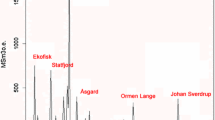Abstract
An alternative to time sequence evaluation of field size distributions is presented. Oil fields are ranked in relation to level of prior exploration in the vicinity of discovery wells. Field size distribution patterns for discoveries at sequential levels of prior exploration are evaluated independently from the time sequence of discoveries within the region. Interregional comparisons are made in terms of field discoveries at equivalent levels of prior exploration. The study area covers a large region (approximately 78,000 Km 2 ) of central and northwest Kansas.
Similar content being viewed by others
References
Attanasi, E. D., 1981, Exploration decisions and firms in the mineral industries: Energy Econ., v. 3, no. 2, p. 105–112.
Drew, L. J., 1966, Grid drilling exploration and its application to the search for petroleum: University Park, Pennsylvania State University, unpublished PhD. thesis, 141 p.
Drew, L. J., 1967, Grid drilling exploration and its application to the search for petroleum: Econ. Geol., v. 62, no. 5, p. 698–710.
Drew, L. J., 1979, Pattern drilling exploration: Optimum pattern types and hole spacings when searching for elliptical shaped targets: Jour. Math. Geol., v. 11, no. 2, p. 223–254.
Drew, L. J., Schuenemeyer, J. H., and Root, D. H., 1980, Petroleum-resource appraisal and discovery rate forecasting in partially explored regions—an application to the Denver Basin: U.S. Geological Survey Professional Paper 1138-A, p. A1-A11.
Gill, D. and Gabai, R., 1983, Oil prospects of the Helez Formation, southern Hashephela region, Israel: Evaluation of the thoroughness of search achieved by past exploration: Jour. Math. Geol., v. 15, no. 1, p. 211–215.
Kaufman, G. M., and Wang, J. W., 1980, Model mis-specification and the Princeton study of volume and area of oil fields and their impact on the order of discovery: Energy Laboratory Working Paper, no. MIT-EL 80-003WP, Massachusetts Institute of Technology, 21 p.
Ramsey, J. B., 1980, The economics of oil exploration—a probability-of-ruin approach: Energy Econ., v. 2, no. 1, p. 14–30.
Schuenemeyer, J. A., and Drew, J. D., 1983. A procedure to estimate the parent population of the size of oil and gas fields as revealed by a study of economic truncation: Jour. Math. Geol., v. 15, no. 1, p. 145–161.
Singer, D. A., 1976, RESIN, a Fortran IV program for determining the area of influence of samples or drill holes in resource target search: Comp. Geosci., v. 2, no. 2, p. 249–260.
Singer, D. A. and Drew, L. J., 1976, The area of influence of an exploratory hole: Econ. Geol., v. 71, no. 3, p. 642–647.
Author information
Authors and Affiliations
Rights and permissions
About this article
Cite this article
Collins, D.R. Changes in drilling density and discovery rates through time. Mathematical Geology 17, 375–393 (1985). https://doi.org/10.1007/BF01032928
Received:
Accepted:
Issue Date:
DOI: https://doi.org/10.1007/BF01032928



